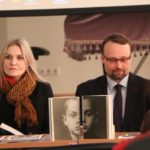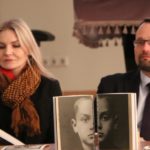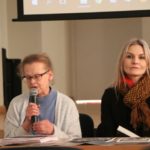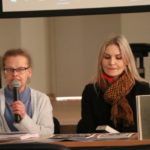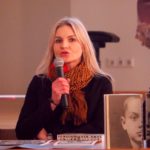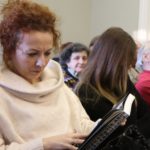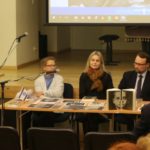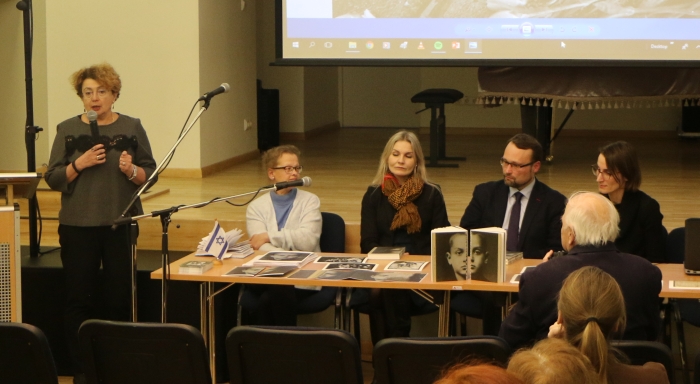
The Lithuanian Jewish Community hosted a second, more public launch of the new Lithuanian translation of the Yitzhak Rudashevski Vilnius ghetto diary Tuesday, following last month’s and exclusive initial presentation at the Vilnius Book Fair.
Rudashevski was 14 when he and his parents were imprisoned in the Vilnius ghetto. He celebrated his 15th birthday there. The family hid during the ghetto liquidation, were discovered and then murdered, presumably at Ponar outside Vilnius. Over the last two decades Rudashevski’s diary has emerged as one of a handful of testimonies by children. It was initially published in extracts in the original Yiddish in Israel, and then in English in 1973. An older and newer French translation ha4xandra Zapruder’s books about children in the Holocaust and in a documentary on the same topic aired on MTV.
Audience and panel members mingled before the event Tuesday evening. A middle-aged woman who seemed to be engaged in teaching the Holocaust to children asked panel speaker and Vilna Gaon State Jewish Museum History Department director Neringa Latvytė-Gustaitienė about a passage she found in the French translation but couldn’t find in the new Lithuanian book. She also said she had no idea where to buy the book and couldn’t find a copy anywhere. Another member of the audience told her the Lithuanian version just published isn’t the complete diary and there are numerous other quotes from the diary in other languages on the internet. This edition is a Lithuanian translation of selections Abraham Sutzkever published in his Yiddish literary journal after the war, he said.
Lithuanian Jewish Community chairwoman Faina Kukliansky opened the event with a brief statement and passed the microphone to the moderator, Dr. Lara Lempert, director of the Judaica Center at the Lithuanian National Martynas Mažvydas Library. A man then played the partisan hymn, Zog Nit Keynmol, on acoustic guitar, singing the words out loud. The mixed Lithuanian and Jewish audience at first remain seated but belatedly stood for the anthem. Dr. Lempert then introduced the subject briefly, noting she had been surprised to learn new information about the author of the diary and his cousin who rescued the diary from the ruins of the ghetto after the Red Army drove the Nazi regime out. She asked Latvytė-Gustaitienė to explain some of the new details which had come to light. Lempert was surprised to learn some of the family members were still alive.
Latvytė-Gustaitienė related staying at a hotel in Israel several years ago and discovering Sara Voloshin lived nearby. Voloshin was Rudashevski’s cousin who joined the anti-Nazi Soviet partisans and survived the Holocaust, later returning to Vilnius and retrieving the Rudashevski diary written in a schoolboy’s notebook. Latvytė-Gustaitienė contacted her, elicited her testimony and recorded it. It is conserved in the collections of the Vilna Gaon Museum. Voloshin is still alive and isn’t entirely happy with what happened to her cousin’s diary. She wants it as a family heirloom. Initially she had loaned it to Abraham Sutzkever and the other people behind the ill-fated Jewish Museum in post-WWII Vilnius which only survived a few years. Sutzkever spirited it away when he went to Israel, apparently, and it is now in the possession of the YIVO in New York City. Latvytė-Gustaitienė said Voloshin never gave the diary to anyone and had only loaned it out for display at the Jewish Museum in post-war Vilnius.
Latvytė-Gustaitienė said it’s possible to get the facts right and still miss the real picture. As an example, she said it’s commonly written Sara Voloshin “escaped Ponar” and joined the Soviet partisans. That’s true to the extent Ponar symbolizes the mass murder of the Jews, but Voloshin told her the real story: she escaped from or on the way to Lukiškės prison. Her mother told her she was young, had strong legs and should escape if the opportunity presented itself, as they were being marched with other Jews to the prison in Vilnius. Sara Voloshin did escape and went to her mother’s friend in the Antakalnis neighborhood, a Polish woman who was completely shocked to see her and afraid for her own life. After hiding her for several months she arranged for the 15-year-old girl, with no combat training and weapon, to travel to the forest to meet up with the Soviet partisans. Latvytė-Gustaitienė said Voloshin said Rudashevski was also young and could have escaped, but had surrendered to fate and wanted to join his murdered grandmother. Voloshin said the death of his grandmother affected Rudashevski deeply, and his remorse over her loss only deepened with time.
Dr. Mindaugas Kvietkauskas, the Lithuanian yiddishist who was the main editor of the new Lithuanian edition of the diary, said the bilingual book–the second half of the book reading from left to right is the Yiddish extracts Sutzkever published–is something which Lithuanians should have if only to have a Jewish book in the house. He read a passage in Yiddish, and then a longer portion beginning in the same place in Lithuanian. Besides translating to Lithuanian, Kvietkauskas wrote a comprehensive introduction, which was translated to Yiddish by Akvilė Grigorivičiūtė, another Lithuanian Yiddish scholar who is working on her doctoral thesis at the Sorbonne. Kvietkauskas said they had proven Lithuanians could publish a book in Yiddish and presented this as a point of national pride. Some audience members clapped.
Neringa Latvytė-Gustaitienė then spoke authoritatively on her experience about the difficulties of teaching the Holocaust to children at the museum and in general.
Famous Lithuanian designer and designer of this book Sigutė Chlebinskaitė spoke emotionally of her struggle with the contents and difficulties doing justice to the design aspect of the book. She said she went with the idea of a cover-less book to make it look more like an actually diary. The book has a cover made out of the same paper as that used in the body, with a slightly thicker weight. The spine is open with the sheaves stamped with Yitzhak Rudashevski’s name in Yiddish in an off-black ink, with stitching and mucilage overlaid.
Mindaugas Kvietkauskas spoke about the history of the diary and how Rudashevski wrote as a mature observer of events, “beyond his years.” On the other hand, Kvietkauskas said it was impossible to dispute a child’s testimony. He ended by reading a poem in Lithuanian about the Holocaust.
During audience questions the woman wondering about the missing passage said she hadn’t known where to buy the book but now knew it was available at the Bagel Shop Café at the LJC at Pylimo street no. 4 in Vilnius. It is also available via internet at www.gvf.lt
Another woman asked about the multiplicity of English and French editions. According to the panelists the initial English edition published by the Ghetto Fighters House in Israel in 1973 was long out of print. LJC chairwoman Faina Kukliansky said they were planning to release a new English edition soon. She also closed the event, saying that while politicians discuss making 2019 “The Year of the Jew” (without consulting the actual Jewish community), all Lithuanians really need to do is to read Rudashevski’s diary. Jews don’t need to ask not to be discriminated against, the understanding will come naturally to Lithuanians that Jews are people just like them. She said she was proud the LJC had finally published the book and thanked the entire team who worked on it. She said Jews are looking forward to the upcoming holiday of Passover, just as Christians are looking forward to Easter, and told audience members to take a box of matzo bread with them from the table in the foyer of the auditorium. “As you leave, please take a box of matzo with you, matzo, that mythical food. When I was a kid, other kids thought matzo was made with a drop of Jewish [sic] blood, and so when they saw the real thing, they thought it should be wetter somehow, something you could knead in your hands.”
Long tables in the foyer were stacked high with kosher matzo boxes and audience members lingered and chatted there for some time.
Photographs by Dovilė Abromavičiūtė


